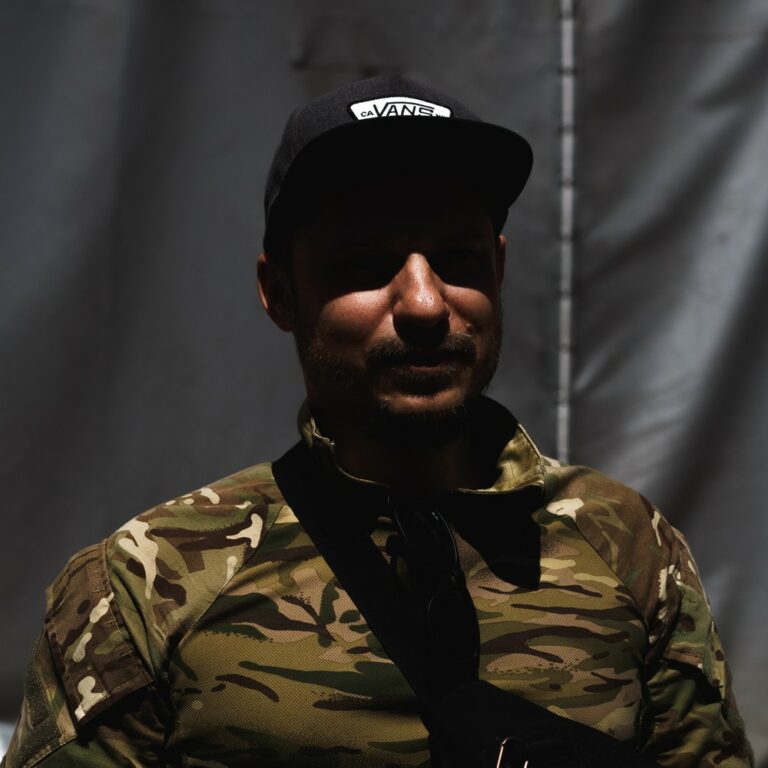The people of Zaporizhzhia have been living under constant Russian shelling since the beginning of the full-scale invasion. Russian troops are damaging critical infrastructure facilities and destroying the homes of civilians. During October 2022, the number of rocket attacks on the city increased. The invaders are desperately trying to occupy new territories in the region but are making no progress. Despite everything, the residents of the city continue to resist.
*
This article contains links to Russian sites, which you can view through a VPN.Zaporizhzhia is known for more than just its Cossack heritage and the national reserve on the island of Khortytsia. This city is one of the largest industrial centres of the country where metallurgical complexes, machine-building, and mining enterprises are located. Some of them, including the Zaporizhzhia NPP (The Zaporizhzhia Nuclear Power Station), have been placed under temporary Russian occupation. But the city continues to work, help its people, and fight.

We talked earlier about the cultural and informational front that the residents of Zaporizhzhia have deployed. In this article, we share the stories of citizens who stood up for the defence of the city — they began actively creating volunteer groups and joining the ranks of the Armed Forces of Ukraine. Volunteers and soldiers — as powerful as “Zaporizhstal” — continue to work for the benefit of Ukraine, bringing our victory closer.
Anton: Find what is needed
Anton Kozyrev is one of the representatives of the volunteer group Sho ty, Diadia? (Wassup, Uncle? — ed.), which helps the Armed Forces of Ukraine, the police, the Territorial Defence Forces, medics, and rescuers. The volunteer association focuses on providing defenders with necessary equipment as well as medicine and medical tools for tactical first aid, such as tourniquets, stretchers, and devices for operative surgery.

Anton was born in Zaporizhzhia. For some time, he had been working at a mine in the city of Dniprorudne. Later, he became the head of the social sphere department of the Zaporizhzhia iron ore plant and a local deputy. Now Dniprorudne is under temporary occupation. They are trying to keep the local mine in working condition, but many people have left the city. After the establishment of the occupying power, the occupiers and their henchmen began kidnapping Ukrainian activists in Dniprorudne.
“On Thursday and Friday (February 24-25, 2022 — ed.), I was at work (in Dniprorudne). On Friday, as usual, I went home to my family in Zaporizhzhia. And on Monday, I could not return to work, because heavy equipment was already moving near Vasylivka. There was no way through.”
Once in Zaporizhzhia, Anton immediately went to the volunteer centre. He met his acquaintances there, with whom he started volunteering back in 2015 — they were exclusively engaged in helping the military at that time. He says that at first everyone had the intention of helping in whatever way they could, then they created a joint chat with those willing to join, and only then everything grew into a volunteer association. They realised that together they could help more people.
In addition to ammunition for the military, Sho ty, Diadia? provides humanitarian assistance to displaced persons from Mariupol, Berdyansk, and other cities and collects and sells medicine for both people and animals.
“When you volunteer, it is very difficult to separate one from the other (directions of work. — ed.). We realised that we need to remember all our skills, unite and react very quickly to what is happening.”

Now Sho ty, Diadia? has about 20 volunteers. In their warehouse, you can see many things that are necessary for the Ukrainian military, from sleeping bags to cans of stewed meat, peas, and sunflower oil. Anton says that the name of their volunteer group appeared because during the war, everyone asked each other “Wassup, Uncle?.” Now it’s the internal meme of their Democratychna Sokyra (the Democratic Horde) team — many people from that organisation joined Sho ty, Diadia? The raccoon logo appeared later.
“This process, when we search and find everything we need, is called ‘raccoon hunting’. We even have a contact zoo (in Zaporizhzhia). There is a live raccoon. We have taken care of it. We go to visit it.”

In addition to buying batteries for recharging gadgets on the frontline, volunteers of Sho ty, Diadia? also put to work their own skills. For example, engineer Serhiy Kontseus often helps them. Together with Serhiy, the team manufactures power banks and batteries for thermal imagers, sews body armour from Turkish steel, and also creates chemical heaters.
“A chemical heater is such an interesting thing. If water is added here (to the mixture. — ed.), it will heat up to 50–60 °C. And this package can be put in a pocket or in gloves. In fact, this thing does not need any rare elements — it is ordinary wooden sawdust, aluminum sawdust, and vitriol. By the way, it was fun to drive through the checkpoints when you have copper vitriol in your car because it looks, mildly speaking, like the methamphetamine shown in TV series.”

The usual working day of a volunteer is spent in constant concern. Anton says that he was able to stay at home only once when a curfew was announced in the city (from 7 p.m. on May 8 to 5 a.m. on May 10, 2022). For those who also volunteer, Anton has two pieces of advice. First, check the information thoroughly and contact directly the person or department that needs help. Secondly, do not neglect reporting, because it is necessary to understand clearly that every dollar was spent as intended.

The independence and organised nature of the volunteer movement in Zaporizhzhia stand out to Anton. During the first week of the full-scale invasion, about 10 volunteer associations and many more individual volunteers appeared in the city ready to help.
“I have been to many places in Ukraine, but Zaporizhzhia and Kyiv are the cities that do not need a command from above. Here, people are like working ants — as soon as some events unfold, you don’t even have time to understand how it all went.”
Serhii: Do-it-yourself help
Serhii Kontseus has been an activist of the Democratychna Sokyra organisation since 2019. A native of Odesa, he grew up in Zaporizhzhia, and there he graduated from the Zaporizhzhia Polytechnic National University. Before the full-scale invasion, Serhii had been repairing and selling office equipment, and now he is volunteering. In particular, he closely cooperates with the association Sho ty, Diadia?.
“On February 24, we were in Zaporizhzhia and woke up to explosions. One night in a bomb shelter was enough for me to start acting. Sitting and waiting for it to end is not my thing.”
Democratychna Sokyra (the Democratic Horde)
The global movement of Ukrainians with right-liberal views. Also the political party of the same name. Right-wing liberalism assumes a minimum of restrictions for the economy and a maximum of freedom for citizens.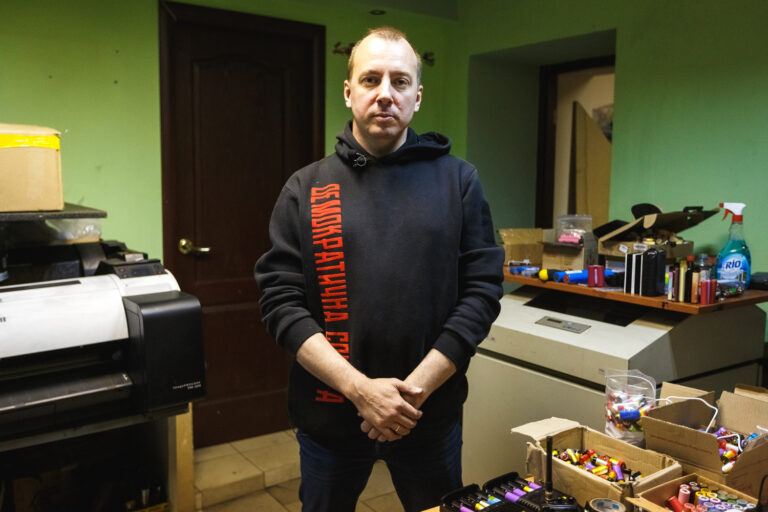
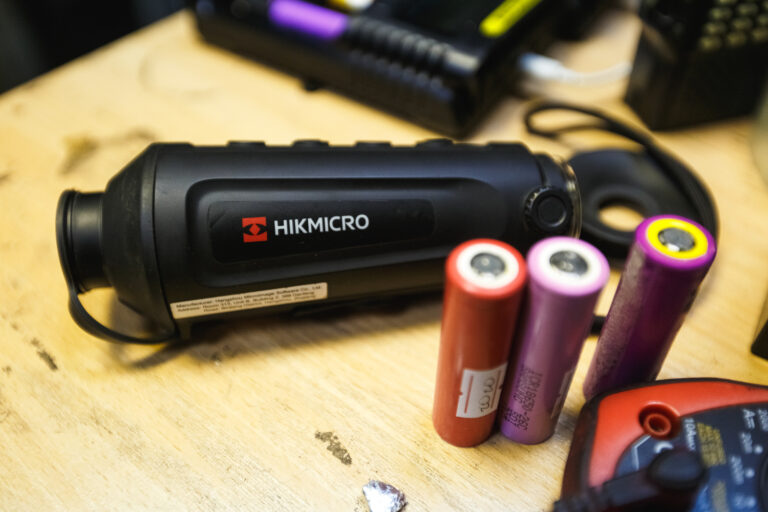
slideshow
In his workshop, Serhii and his team repair equipment for the military, such as quadcopters and thermal imagers. It was also necessary to repair anti-tank missiles, for example, NLAWs, which sometimes do not work due to faulty batteries. An NLAW is a portable anti-tank guided missile. It has a light weight (about 12 kilograms) and a firing range of up to 800 metres, suitable for destroying enemy armoured vehicles. Serhii’s team not only fixed two NLAWs but also recorded video instructions so that other volunteers could also help in this matter. In addition, they are engaged in their own production of devices necessary for the Ukrainian military. They focus on electronics, like batteries and power banks.
“We do not deal with any matter. We choose those things that we can do and that cannot be done by others.”

Serhii says that his volunteer team has to be inventive. For example, they recycle batteries from disposable electronic cigarettes so that they can be used for thermal imagers. The resulting products are similar to industrial products but have better characteristics — they are enough for at least a week of work. In addition, unlike batteries, the batteries “pumped” by Serhii’s team can be recharged. In order to collect enough electronic cigarettes, they asked for help on social networks — their post was shared by about 1,300 people. After that, Serhii began receiving parcels with these raw materials from all over Ukraine.
“The environmental friendliness of our society is also impressive because people did not throw them (disposable cigarettes — ed.) away. They are harmful. They must be processed. And then we opened this ‘portal’: we said that we accept ‘one-time’ applications, that our defenders need them. And how it went!”

Another area of work of Serhii’s team is the production of their own power banks. The cases for them are printed on a 3D printer. The power of such a gadget is from 10,000 milliamps, which is enough to charge a smartphone or tablet several times. It takes about 20 to 30 minutes to make a power bank. Much more time is spent on finding and delivering components. Serhii says that their power banks are cheaper than industrial ones, and they are also quite easy to manufacture:
“We recorded a video and have shown that these power banks can be made by almost anyone with hands.”
Serhii says that earlier in Zaporizhzhia there were many connoisseurs of the “Russian World”, and the region was considered Russian-speaking. Now he understands that this was the result of the policy of Russification. However, since the start of the full-scale invasion, the mood in the city has changed — people have started to unite and help each other and the army.
“Our population has become smaller, but the nation has become larger.”
Serhii stays in Zaporizhzhia with his wife and child. He considers his city to be beautiful and cosy and the people to be open and united.:
“The most inspiring thing is that we have no other way out. We have to win.”

Volunteers in Zaporizhzhia, according to Serhii do a great job: they provide for the needs of the military, supply food, and weld Czech hedgehogs. Serhii recalls the story of how, during a work trip, one of the local residents gave him a quadcopter that he had bought for his son — he said the military needed it more now.
“The resistance of the city is held by Ukrainians, in particular by Zaporizhzhia residents, because we are not indifferent — we want to live here, and we live here.”
Taras: Don’t wet your pants, stay strong, and work hard as f*ck
Taras Bilka is a YouTube blogger who runs the NE STSIAT channel. The channel got its name from the phrase Taras is known for in the Ukrainian community: “Ne scym, stoim, ibashim” (Don’t wet your pants, stay strong, and work hard as f*ck — ed.). In the past, he worked as a journalist and headed a media outlet called Suspilne. Zaporizhzhia. He also volunteered and founded a brewery called Synia Bilka Craft Beer. On his YouTube channel, you can even find a series of expeditions to different breweries around Ukraine.
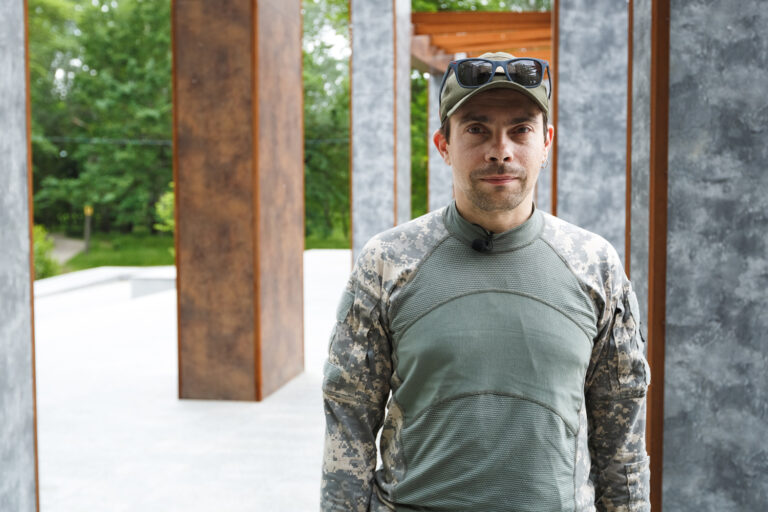
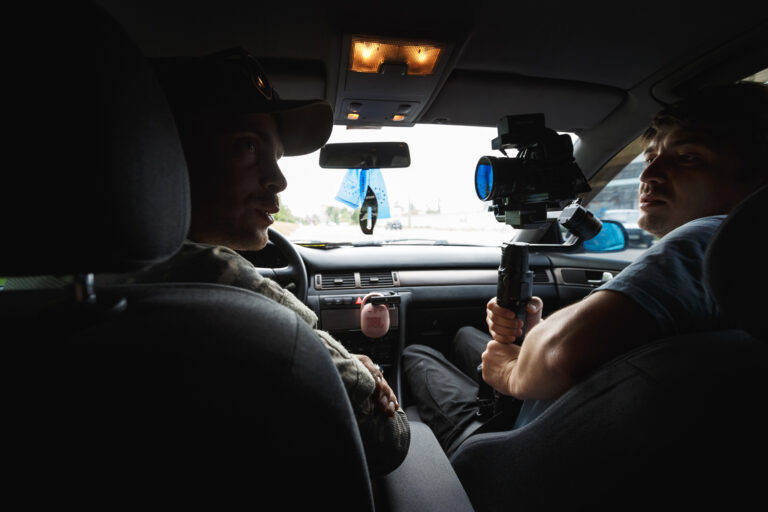
slideshow
As of February 2023, Taras’s YouTube channel has more than 70,000 subscribers. In a day, he can release up to four videos — these are streams, special editions, morning videos “Ne scym, stoim, ibashim” and evening “chronicles of war”. In “Chronicles” he communicates with the military and also documents his own news and emotional states:
“I don’t want to lose anything important, because I see this victorious path of Ukraine, and I have to somehow tell it to my children and grandchildren. And video chronicles (I record) because you can see how a person changes.”

The column “Ne scym, stoim, ibashim” appeared as a continuation of the vlog that Taras recorded in his previous peaceful life. He discussed the topics of burnout and panic attacks then. After the start of the full-scale invasion, he continued to analyse various psychological issues. In particular, he analyses the psycho-emotional state of Ukrainians (civilian and military) and the occupiers every day, showing how they change and what we should be prepared for soon. By studying certain triggers (events or things that can cause a person to experience), Taras quite accurately predicts when we will feel euphoria and when we will feel despair.

Triggers that determine the psycho-emotional state can be various events — news about the atrocities in Bucha or discussions of the World Economic Forum’s participants about the course of the Russian-Ukrainian war and its global impact on other countries. According to Taras, in times of great psychological stress, it is very important to predict changes in one’s own mood.
“You understand what can be expected of you, and this is a very cool skill. For example, you know that you will be more irritable during the day, and you understand how to avoid conflicts.”
A focus group, as well as volunteer psychologists from different countries of the world, help Taras to determine psycho-emotional states. He himself started visiting a psychologist in 2014, when the Russian Federation launched a war in the East and occupied the Crimean peninsula. At that time, Taras travelled to the Donetsk region as a journalist and repeatedly came under fire and lost friends in battle. Talking to the military, Taras notices that they rarely seek psychological help:
“I spoke with a marine who left Mariupol wounded. He explained why they don’t go to a psychologist. Because (psychologists) immediately look for some kind of trauma, make diagnoses, and this is done by a person who is not close to the war, did not see it and did not lose relatives there.”
However, Taras is convinced that qualified psychological help is very necessary for people who have experienced traumatic events. In particular, this should be done by military psychologists with experience in participating in hostilities or conditions close to them. But, according to Taras, unfortunately, there are very few such specialists.

He also observes that the excitement of civilians can worsen the emotional state of the military, for example, when civilians succumb to the informational provocations of the enemy and spread false information by calling their relatives at the front. According to Taras, despite the protracted war, many people still haven’t learned the basic rules of information hygiene — to check sources, limit information consumption, trust only official messages, and not spread posts based on emotions.
Information and psychological operations (IPSO) and disinformation is a topic that Taras pays a lot of attention to; in particular, he recorded a special video for his channel about it. In it, he explains how, with the help of separate information campaigns (stories about the “crucified boy” or the chevrons of the national regiment Azov in the Russian Museum of Victory)), propagandists of the Russian Federation achieve their main goal of convincing both Russians and the world community that all Ukrainians are neo-fascists.
“IPSO is now a tool of warfare, which has not been paid enough attention at all. And then, when you understand how IPSO work, it turns out that you don’t know how to manage people.”
The story of the "crucified boy"
The story of the Russian First Channel in July 2014, in which a woman told how she allegedly saw with her own eyes the execution of the young son and wife of a "militia". According to her, this was done by the Ukrainian military in the central square of Sloviansk.
In his videos, Taras tries to explain complex things in simple words. He uses visual materials such as stickers, appliqués, and even Kinder Surprise chocolate egg figurines. Yes, he has stickers of different colours to indicate psycho-emotional states. Yellow stickers on the graphic represent civilians, blue represent military, and red represent occupiers. Visualisation is also used to explain historical contexts.
Taras explains that using the example of stickers from comics by American Roy Lichtenstein — one of the most famous creators of pop art — is much easier to explain the meaning and mechanics of obtaining a lend-lease, the system of supplying weapons, equipment, ammunition, and raw materials from the United States to Ukraine. The blogger also has a video about this.

Regarding his media activity, Taras says that now there is a noticeable trend toward Ukrainian language and media content. So, for example, in 2021, views of Ukrainian YouTube channels increased by 30%. But Taras believes that simply giving up Russian-language content is not enough — we need to create qualitу Ukrainian content to convey our narratives.
“The only war that we lost completely, and only now we are trying to get the status quo, is the war on YouTube.”
In addition to the information struggle, Taras cooperates with the Ukrainian Air Intelligence, supplying it with necessary drones. He believes that in modern warfare, it is impossible to overestimate the importance of drones — they not only help to adjust fire but also save the lives of infantry reconnaissance.
“If in 2014 we had drones that fly like that and can do that, then we wouldn’t have to wait eight years. Ukraine would already be independent from its lichen neighbour.”
Taras often joins volunteer meetings, but he does not consider himself a volunteer. He notes, however, that now there is a great rebirth and unity of the Ukrainian nation, in particular in volunteering.
“The fracture occurs on some tectonic level. From a nation of breadmakers, we became a nation of warriors, with an additional hidden gene of volunteering.”
Pavlo: Copter operator
Pavlo Pashko is a sound director and operator who has been working with the Ukraїner team since 2016 (the first operator in the project). When the full-scale invasion began, he went to the military commissariat but got rejected due to his lack of combat experience. After that, Pavlo contacted friends who helped him sign up for the local volunteer territorial defence formation called Azov. From there, he got to the newly formed air reconnaissance unit.

On the eve of February 24, Pavlo sensed the approach of a new stage of the Russian-Ukrainian war. He thought that he wouldn’t be able to prepare for everything, but still bought some things like bars, water, and filters. After joining the army, he noted that a large part of the work to provide for the soldiers is done by volunteers.
“Our volunteers, whom we have known since 2014, now simply started doing many times more. Everyone turned in 150%, plus new people joined.”

Pavlo is currently actively using the professional skills he had as a civilian copter operator. It was him who shot most of the Ukraїner video content with the help of an “iron bird” (a drone), and in the autumn of this year the photo book Ukraine from Above was published, where most of the pictures of Ukraine from the sky are the work of Pavlo. Despite the fact that he joined the defence of the country from the very beginning of the full-scale invasion, he believes that he can do even more for the Armed Forces and air reconnaissance.
“It seems that you are doing what you can, sharing information, developing, but on the other hand, you understand that you probably can do more.”

Pavlo says that victory for him is the return of Ukrainian territories — Crimea and the East — as well as a change in the economic and cultural development of the country, in particular, the consumer habits of Ukrainians. He already sees how people are beginning to abandon the Russian cultural product and sever ties with the business of the aggressor country.
“I understand that this is a long process, but the direction is very correct. We must maintain this direction and pace, and in a couple of years, we will see very cool changes.”
After the victory, Pavlo wants Ukraine to be spoken about honestly, both here and abroad. After all, there will be no development without constructive criticism.
“You should always look at Ukraine as it is. It is not as simple as it seems. We all look heroic and cool, but you have to understand that we have a lot to work on. And the more honestly we look at ourselves, the faster we will draw conclusions.”

